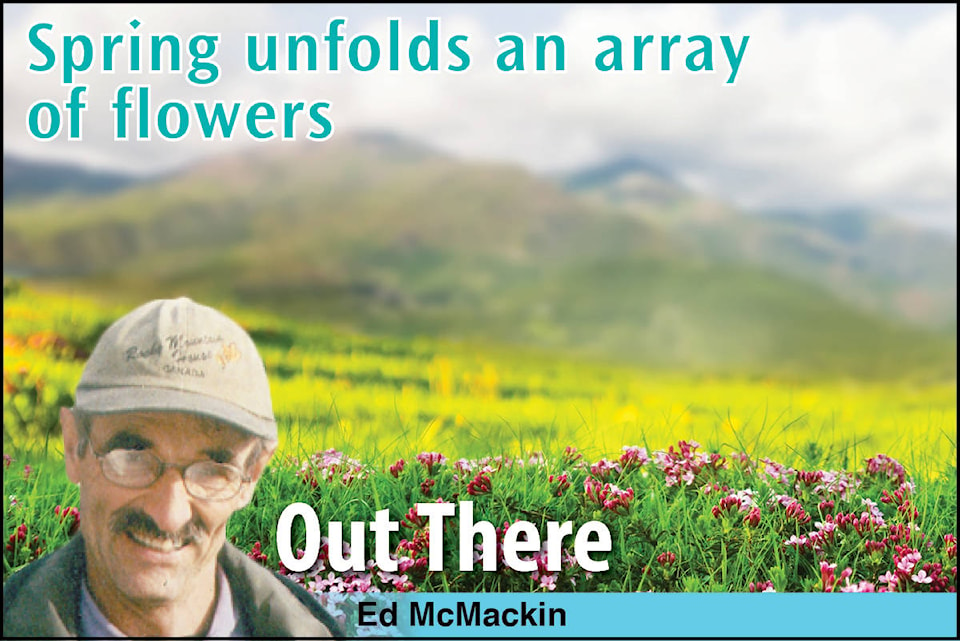The Western Mountain Region of North America, from the Pacific Coast and eastward to the Prairie, Great Plains Region, must have the greatest diversity of flowering and non-flowering plants on the Continent. The significant factor for this diversity is the mountain and valley landscape producing diverse habitat through elevation and aspect affected temperature and moisture. The Kootenay-Columbia Mountain System are as much a part of this diversity as any other mountain region.
Three main plant communities contribute to our earlier spring flowers – open south and west aspects (southland west facing slopes) edges and shrubby open south aspects and open mixed forest where there are both deciduous and coniferous trees.
Our first spring flowers, sagebrush buttercups, yellow glacier lilies, mountain bluebells, yellow bell and spring beauty, of open south and west aspects have largely wilted and are now developing seeds, making way for shooting star, the purple, single-flowered, broom-drape, marsh saxifrage, a white biscuit-root, and two yellow varieties of wild parsley. Now, meadow deathcamas, wild hyacinth (Tritellia), Clarkia, and wild onion have robust buds or, by the time you may read this, have already opened. Many flowers of south aspects may be found later in spring, higher up or on more north aspects. Glacier lilies bloom in July at 7-8000 feet, in mountain meadows.
On shrubby slopes and in lightly treed areas blue-eyed Mary and ball-head water leaf have been blooming for several weeks. These flowers come later than those of open slopes. In some situations, shade-producing shrubbery results in cooler temperatures so the first blooms come later than those on open, south or south-west aspects. Occasionally, an isolated, low -growing shrub will have a greenhouse-affect and glacier lilies, growing within the bounds of the shrub, will bloom earlier than on the adjacent open slope, exposed to wind. Remember to search out the sunflowers – arnica and balsamroot.
Open forest, often having a mix of coniferous and deciduous trees, lets in adequate sunlight for spring flowering, perhaps a month after the first flowers appear on open south-facing aspects. One of the most striking blooms in this habitat is western white trillium. Its survival along trails is at risk as some admirers pick the flower and stem which also bears the leaves, hence the plant is less likely to bloom the next year. Woodland flowers to appear after the trillium, are calypso orchid (aka fairy slipper) and mountain lady’s slipper. Along with these, one may discover the very small round-leaved violet. This yellow flower perhaps more commonly, found along edges of and openings in the coniferous forest, often opens sooner than the yellow wood violet found in open mixed forests.
In our open mixed forest, the flower line-up includes false Solomon’s seal and fairy bells (two species). Starry Solomon’s seal is most abundant in and around edges of stands of cottonwood trees. A handy spot for viewing them is on the East side of Nick’s Island South Road just north of the bridge.
In more shaded forest areas flowers occur in late May and, depending on the elevation and aspect, continue on through to mid-summer. Examples of these are striped, western, yellow and spotted coral-roots. In their preferred habitats, Indian pipe, pinedrops, single delight, green-flowered, small, and large pyrola (wintergreens), as well as prince’s pine and little pippsissewa (hard-to-find), may be found.
The foregoing flowers is basically a rundown of spring flowers found in the Kootenay Lake District and, more specifically, where you are apt to find them It is certainly not a complete list as it excludes some obscure, hard-to-find, rare and a few very common species. For identification, I recommend “Plants of the Southern Interior of British Columbia”, or the updated edition that includes Northern Idaho and Washington, by Parish, Coupe, and Lloyd. Most of the flowers mentioned may be found in this book. If you use another book make sure it is for Western Canada or covers the Pacific Northwest.
Enjoy flower hunting! (If you expand your quest into the U. S you may be labeled as a “daffodil hunter.”)
